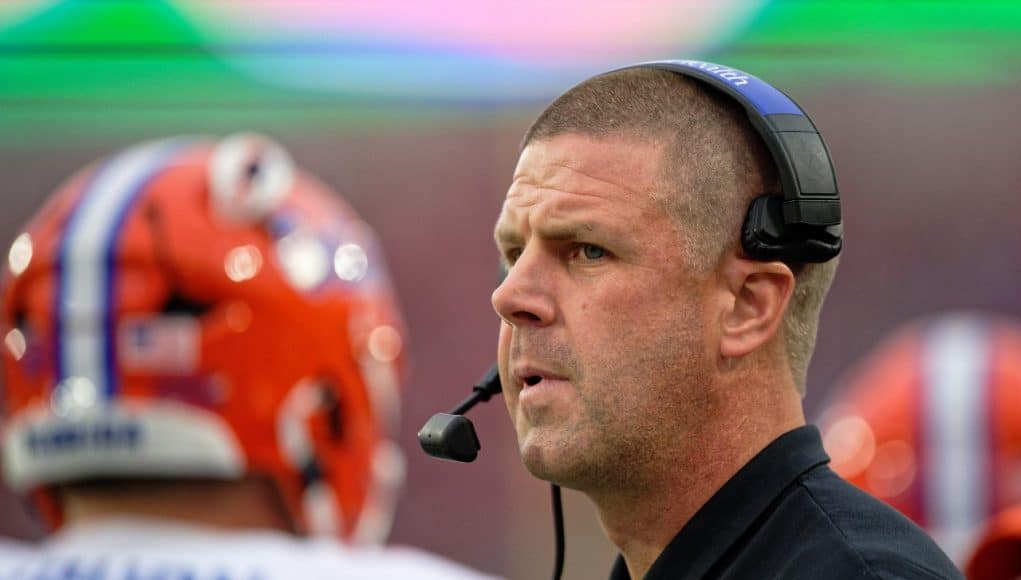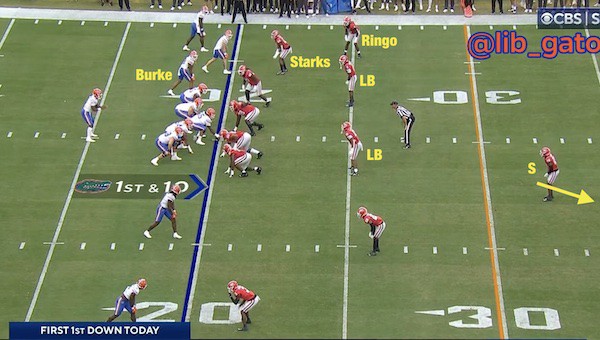You often hear announcers proclaim that a team made adjustments at halftime when a team performs better after the break. Sometimes it’s true; sometimes it’s not. It’s just a thing that broadcasters have developed a habit of saying regardless.
Florida’s offense did make some adjustments, though, and that’s why they moved the ball a lot better after intermission than before.
Before the break
There’s not a lot to say here. Before halftime, Florida largely ran the same offense it has all year.
That fact drove me batty. Georgia’s defense isn’t as good as it was last year, but it’s still great. It’s one of the best in the country this season, and it’d be one of the best in the country in every season.
To expect to come out and run the same old stuff against one of the best when your own offense is inconsistent made no sense to me. It didn’t help that Georgia won nearly every physical confrontation there was. The offensive line flat-out got pushed around early in the game, and that goes for all of them including future first round draft pick O’Cyrus Torrence. He didn’t have it as bad as poor Kingsley Eguakun, who struggled mightily, but no one was immune. Blockers on the outside didn’t fare any better either.
The biggest glaring issue was the near lack of any kind of wheel routes or screen game. Wheels have worked against Kirby Smart defenses dating back to his time as DC at Alabama; it wasn’t at all a fluke that Dan Mullen continually clowned him with that route in 2020. Screens are important too, because they’re a great way to punish an aggressive defense. In fact, they’re the primary way to punish aggressive defenses for most offenses.
The one first down Florida had before intermission was a swing pass to Montrell Johnson. It wasn’t even the plan to do it, as it came in as an audible from the sideline. The blocking still wasn’t perfect as Ricky Pearsall couldn’t hold his, but Georgia was surprised enough and Johnson was in enough space that he could still power through and pick up the needed yardage.
The very next play was the one schematic bright spot. Billy Napier finally spread the field by going five wide, and he caught Georgia in an advantageous alignment.
Credit: CBS, via Lib_Gator
UGA is playing one deep safety. He starts on the offense’s right and will fade back that way.
The triple receivers on the left, therefore, are the job of a linebacker or two, safety Malaki Starks, and corner Kelee Ringo. The Gators over there are Keon Zipperer by the sideline, Pearsall in the middle, and Marcus Burke in the slot.
The Bulldogs are okay as long as all three of those routes are not verticals. The two linebackers drop into zones, so they have anything short. Ringo and Starks will have to take care of anything deeper by themselves.
Zipperer will do a curl at the sticks with Pearsall crossing over to go long up the sideline. Starks passes Pearsall off and covers Zip well, and Ringo has Pearsall just fine. The problem for UGA is that Burke is going vertical. The linebacker on the left passes him off, but there’s no one over there to pass him to. Burke is wide open and has at least a 30-yard gain, but Anthony Richardson sails the pass over his head.
From then on, it’s back to business as usual. Only because of a 41-yard sideline fade to Justin Shorter do the Gators get any points before the break, and they’ve run that play plenty already.
After the break
The first play sets the tone. UF goes five wide again, and it’s a screen to Trevor Etienne. He picks up ten yards, and the Gators move the sticks right away.
Richardson gets a few designed runs finally, and Etienne has rushes of 13 yards and ten yards out of one-back, four wide formations. The offensive line is notably not getting dominated on nearly every snap anymore, which is a credit to them, but also UF ran well by clearing out the center of the formation with spread sets. When they didn’t spread it out, UGA stopped the run just fine on the drive. A last-second shift of Etienne from the pistol to being next to AR while running tempo caused hesitancy in the linebackers and allowed Trevor to punch it in for the Gators’ first touchdown.
To its credit, Georgia’s defense stiffened up after the ensuing turnover to hold UF to a field goal attempt. The best play is Johnson getting an 11-yard gain off of a seldom seen counter run.
The next drive then had the bomb to Xzavier Henderson, and it too was a case of a schematic win. Pearsall and Henderson are split out wide right in a four-receiver, one-back set. Lorenzo Lingard motions out wide left to create an empty set at the snap, which creates insurance for minimizing the number of defenders on the right.
Pearsall runs an out a couple yards past the sticks while Henderson streaks up the sideline. Richardson does a good job of staring down the place where Pearsall will end up on his out to focus the defense there. The timing of the play is such that when AR winds up to throw, all three of him, Pearsall, and Henderson are in a line. The upshot is that the throwing motion will look identical no matter which guy Richardson is targeting. Two Georgia defenders crash on the out route, essentially making Pearsall quadruple covered. Henderson is left unguarded, and Richardson hits him in stride for the score.
A deep route behind a crosser/curl is a classic because the shorter route often draws safeties up and away from the longer one. Steve Spurrier popularized one such combo, named for Ernie Mills, in the 1990s. In that one there is a deep post behind an intermediate crosser where both routes start from the same side of the formation. Shorter’s long touchdown against LSU was basically a variant of that with Henderson’s intermediate cross coming from the opposite side of the formation.
Closing remarks
Florida didn’t score again, but it wasn’t stopped for a three-and-out again either. The next drive only went 24 yards with 20 of them on one pass to Shorter, but Richardson barely missed Pearsall behind the defense two plays later. The following two UF drives went 60 and 40 yards respectively, though the latter was well and truly garbage time.
I can’t tell you whether the adjustments were 100% due to the game state of being down 28-3, 100% to Napier changing his approach based on how things went in the first half, or some combination. I would bet on the combination, with Richardson’s increased designed run workload being the tell that it wasn’t all about game state.
I can only guess why Napier didn’t lead with the stuff he did after the half. My guess, though, is this. He’s famously process oriented; it’s what absolutely everyone says. In fact, he’s the most process and detail oriented coach everyone seems to know in their telling of it. He’s going to start by running what he thinks works best, and if it has problems, he’ll adjust later. He spent a lot of time during the offseason choosing what he thinks his team can succeed with, and he’s going to lean more on what came from long stretches of careful consideration than from what might feel like knee-jerk, snap conclusions mid-season. Again, that’s a guess, but it is at least plausible.
Florida’s offense has been more than adequate in a lot of ways this season. Even after playing Georgia’s tough defense, UF is 30th in the country in yards per play against FBS competition. They’re 22nd among Power 5 teams, and that’s with only one G5 opponent in the mix. They’re a hair in front of Penn State in this measure, and the Nittany Lions have faced both Ohio and Central Michigan and have played a dreadful Northwestern team.
I do think Florida could be even better if it implemented more spread sets and used more route combinations that are designed to put defenders in a bind. A lot of what the Gators do is run something sound and expect their players to beat the defenders. That can work at times, but UF doesn’t have good enough outside playmakers or an accurate enough quarterback to go from good to great at it. Spreading the defense out doesn’t automatically work, but it can at least take away variables by having fewer defenders near the ball at any given time. It’s also what Richardson was accustomed to prior to this season.
The UF offense simply has some obvious holes. It seldom uses screens other than bubbles, and it almost never throws to its running backs except as safety valves. It doesn’t have many quick hitters in the pass game, and it rarely uses tempo. Once Florida started filling in some of those holes in the second half, things worked a lot better.
I’ve given up on predicting what Napier is going to do, because he doesn’t follow patterns that most other coaches do. He’s doing it his way, and that’s going to be the Florida Way as long as he’s at the helm.



